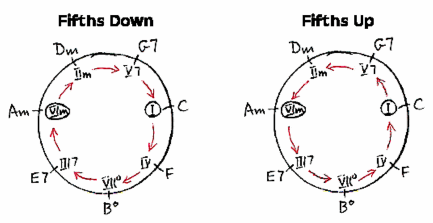Diatonic Circle Progressions
Diatonic Circle Progressions are a form of Circle Progression that is constructed using only those chords from the diatonic scale. The Diatonic Circle Of Fifths, shown below in the key of C, includes only the members of the respective diatonic scale. Dominic Pedler in his book "The Songwriting Secrets of The Beatles" talks about the diatonic circle of fifths like this: "If there is one winning formula at the 'poppy' end of popular music, it is those progressions whose roots follow a predetermined movement descending in intervals of a fifth... Applicable to jazz and classical music as well as to pop, the cycle is an unashamedly formulaic system for exploiting the natural tendency of diatonic chords to follow this predetermined path. It provides a very simple way of appreciating how generations of classic pop songs actually work in practice..."

Comparing the diaonic circle of fifths to the complete circle of fifths below, you can see that all non-diatonic members have been removed. 
Many great songs have been written using Diatonic Circle Progressions. Several well-known examples are shown below. You should compare these to the diatonic circle of fifths above.
All The Things You Are A section - Key of C (1939)K. J. McElrath, Musicologist for JazzStandards.com, explains it this way: "The harmonic progression in the first five measures is identical to that of (the latter written) Fly Me To The Moon. However, where the latter piece returns to its initial key by way of a viiø7 going to V7, this one uses the clever device of a “common-tone” chord to modulate to an entirely new key and then goes on to do this three more times."
|Am7 / / / |Dm7 / / / |G7 / / / |CM7 / / / |
|FM7 / / / |B7 / / / |EM7 / / / | / / / / |
|Em7 / / / |Am7 / / / |D7 / / / |GM7 / / / |
|CM7 / / / |F#7 / / / |BM7 / / / | / / / / ||
Autumn Leaves A section - Key of C / Am (1946)K. J. McElrath comments that "[the] chord progression makes use of the circle of fifths, but in a way quite different than most tunes. The initial progression is ii7- V7- I, followed by a IV chord (similar to All the Things You Are), but then it uses a viiø7 in order to modulate to the relative minor (the viiø7 begins a iiø7-V7 in E minor)."
|Dm7 / / / |G7 / / / |CM7 / / / |FM7 / / / |
|Bm7b5 / / / |E7 / / / |Am7 / / / | / / / / ||
The Shadow of Your Smile A section - Key of C (1965)
|Bm7 / / / |E7 / / / |Am7 / / / |/ / / / |
|Dm7 / / / |G7 / / / |CM7 / / / |/ / / / |
Other examples of Diatonic Circle Progressions include Fly Me To The Moon (1954), Yesterday When I Was Young (1969), I Will Survive (1979), and Still Got The Blues (1990).

About Us |
Chord Progressions |
F.A.Q. |
Freebies |
Guitar Chords |
Guitar Lessons |
Home Page |
Links |
Music News | Site Search |
Songwriting |
Standards |
Store |
Tablature |
WebRings Copyright © 2007
- 2010 MoneyChords.com |